Most organizations struggle with coming up with BIG ideas.
Ask your product team to come up with big bold ideas.
And instead of unique ideas based on deep user insight. Most likely, you will end up getting:
- Old recycled ideas (in new packaging)
- Competitor copy cats
- Pet projects
- Executive’s wish list
Big and bold ideas will be no where insight.
Why? Because the way we generate ideas is broken.
Every product team that I have met, use some kind of brain storming session to generate ideas.
Where a group of product managers sit around the table, throw out a bunch of ideas, and create a prioritized to do list. Many of these sessions look a lot like this comedy sketch (hint: turn your volume down).
There are four fundamental problems with this approach,
#1 Lack of focus:
You get the best ideas when you have clearly defined user and a problem. The more you understand the users and the their needs, the better your chances of coming up with something big.
Most team rarely take the time to do so. Instead they get into the room and start shooting of ideas. No wonder, you end up getting a bunch of mediocre ideas that are all over the place.
#2. Lack of preparation:
The best ideation sessions take a ton of preparation. Rule of thumb for every 1 hour of ideation you need at least 5 hours of prep.
Product teams rarely put it that much time and thought into it. Instead they schedule a brainstorming meeting in the middle of the week. And hope that most people show up.
#3. Not open:
To generate good ideas you need to first generate a lot of bad ideas. To do so, requires an open, collaborative, and non judgmental environment.
If the executive or product leader is running the session, you can pretty much forget about it being open. Real human issues such as fear of being judged, the desire for conformity, or the lack of speaking time will eventually end up taking over the meeting.
#4. Too short, kills the creative process:
The best ideas come at night, or in the shower, or when you are most relaxed. People need time to think – both as a group and alone.
By scheduling sessions to last only for 1 – 2 hours. You pretty much kill the creative process. By the time the team comes home, they have pretty much all but forgotten about the problem / customer.
Here is how you can fix it.
The next time you plan to brainstorm consider the following 4 key steps.
- Step 1: Preparation
- Step 2: Start with the user
- Step 3: Uncover their hidden needs
- Step 4: Ideate & prioritize
I have used this approach several times, both at Google & IBM, with great success. The reason I like this approach is because it combines the best elements of design thinking, modern product development practices, and agile.
Lets looks into each one of the steps in detail.
Step 1: Preparation
This is by far the most important step in the entire process. Get this right and you dramatically increase your chances of getting both quantity and quality of ideas.
At this stage you want to lock down 4 key decisions,
- Narrow down the user(s) and the problem statement: The more specific the better. Try to avoid generic problems like, “come up with new ideas to help us attract more users”. Instead focus on a known user pain point. For example, “design a better way for Mark (user persona) to be able to sign on to the service faster”.
- Identify participants: The natural instinct is to keep the participation limited to the product team. But, if you are looking for well rounded ideas, consider inviting key members / leaders from the development and UX team. As an added benefit, you will get their buy in from the very beginning.
- Pick a facilitator: It is tempting to have one of the product manager facilitate the session. However, in this case, neutrality works in your favor. Ask a product manager from an adjacent team or go outside.
- Book a room & get supplies: Pick a room that has a lot of open walls. They work great for all the stickie exercises. And make sure you have enough of the required office supplies, including stickies, bold black markers, and flip boards.
You could try to jam all of this into a day. But in our experience, it usually takes about 3 – 5 days. So budget accordingly.
Step 2: Start with the user
With the prep work over, now you are ready to workshop.
The goal of this step is to have the team start looking at the problem from the user’s perspective.
To do so, start with the following two exercises.
2.1 Share user’s persona:
To help the team better understand their user, start with sharing the user persona(s). This is a great way to ground the team on the user’s likes / dislikes, why they use the product, frustrations, demographics, age etc.
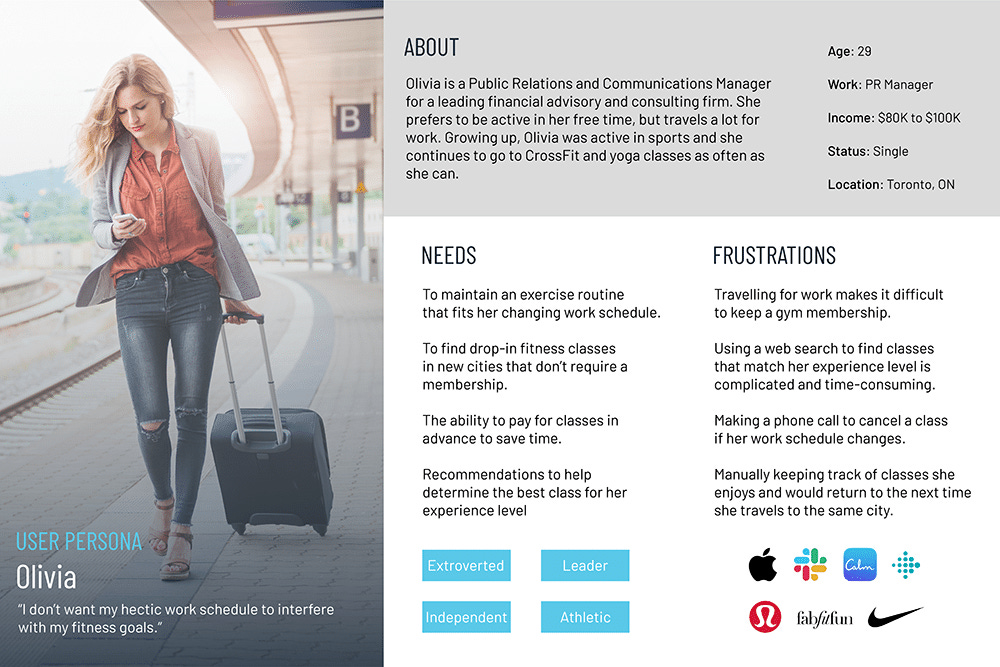
If you have supporting market research, share it. If you can get a user to come in, even better. The goal is to have the team start thinking like the user.
2.2 Build an empathy map:
The next step is to have the team build an empathy map.
Empathy maps are a great way to put the team into the user’s shoes and align on their pains and gains.
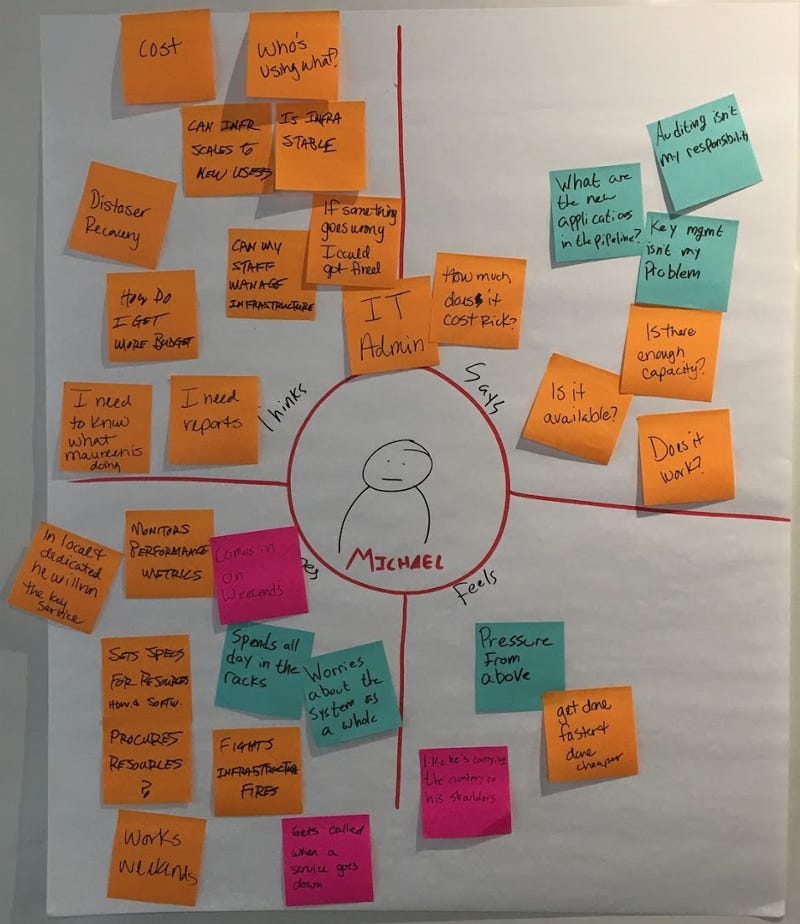
Also, building a map does not have to be hard. Every team member has some information on the user. And by doing it together, the team benefits from a collective point of view and put everyone on the same page.
Step 3: Uncover The User’s Hidden Needs
We are not done thinking like the user yet. The next step is to go beyond the generic overview and uncover their hidden needs.
To get there, consider the following exercises,
3.1 Map the user’s as-is journey:
The goal here is to collectively capture the high level steps (before, after, and during) while the user interacts with your product / experience.
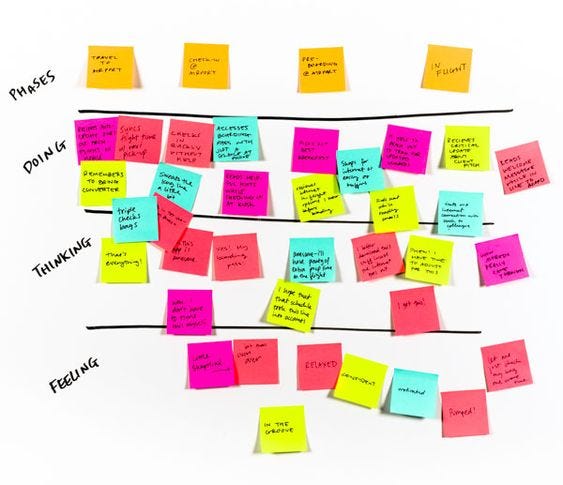
Two key best practices to consider as you map the journey. First capture not just what the user is doing but also what they are thinking and feeling. Second, don’t get bogged down with internal processes. The focus should be on what the customer interacts with.
3.2 Identify pain points:
Once the journey is mapped, the next exercise is to identify points of friction.
This could be anything as simple as the user doing a certain task twice, waiting too long, or not following the prescribed process etc.
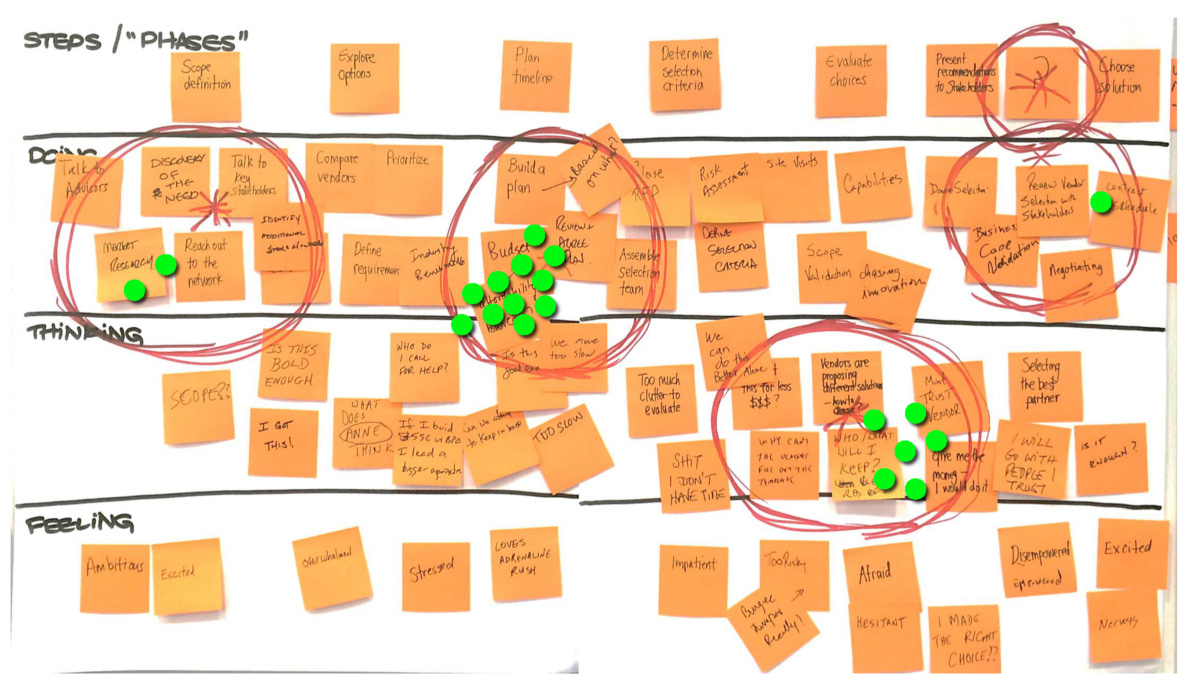
Pay special attention to where the user seems confused or irritated. This is your best source of uncovering hidden needs (that event the user may not be aware of). If you come across too many (which BTW most teams do), you can do a quick prioritization exercise.
3.3 Write need statements:
The next step is to take everything you have done so far and turn it into a problem (user need) statement that you can ideate on. A good need statement consists of three parts – the user, the pain, and the benefit.
For example, Google’s Gmail team used the following need statement to brainstorm a new user experience.
“Mark (heavy Gmail user) needs a way to quickly customize their home screen so that they can be more productive”.
Step 4: Ideate & Prioritize
With the problem and benefit clearly defined, we are now finally ready to come up with big ideas.
Two key exercises to consider,
4.1 Big ideas vignettes:
Borrowing from design thinking workshops, this activity is a great way for teams to brainstorm a breath of possible ideas. The reason I love this technique is because, instead of coming up with a list of ideas, teams are requested to come up with a picture and a headline.
This has two key benefits. First, it allows the team to be creative. Words have a way of blocking the creative juices. And second, drawing allows the team to come up with a ton of ideas rapidly.
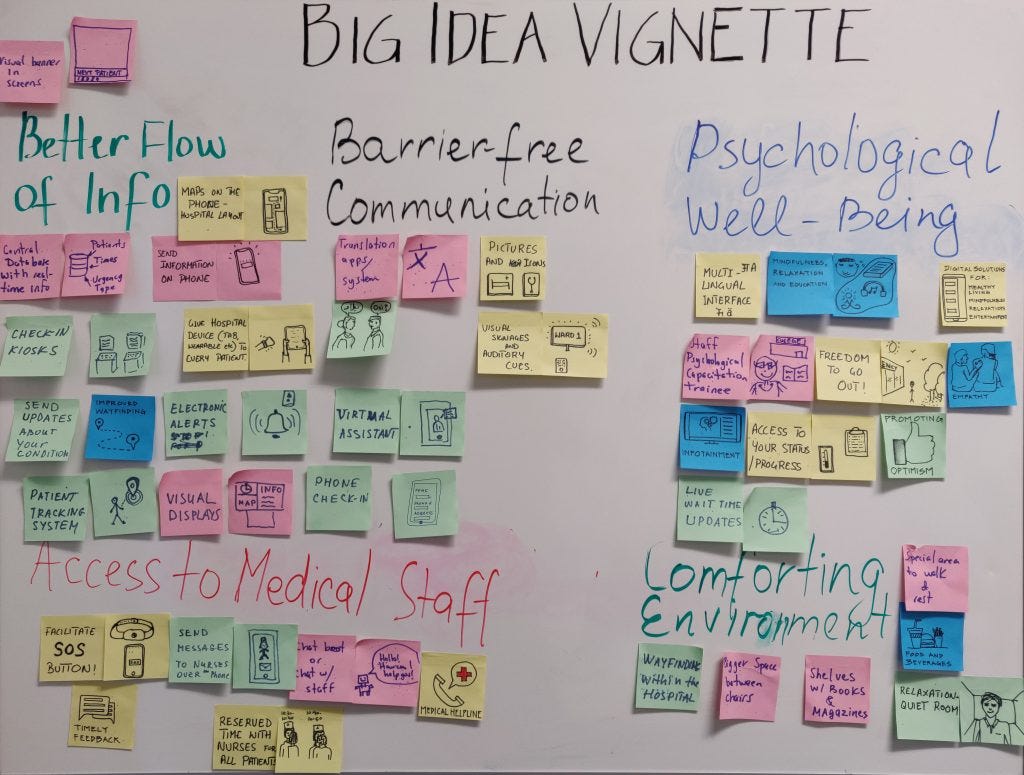
When we ran this for a health care provider, the team was able to generate over 100+ ideas within a span of a few hours.
One piece of advice, avoid evaluating ideas while the team is generating. For best results, dedicate some time to get everyone’s ideas. And then use the next exercise to prioritize.
4.2 Prioritize:
If you run the above session right, you should have a ton of ideas. When we ran this for a health care provider, the team on6 was able to generate over 100+ ideas within a span of a few hours.
Having a lot of ideas, creates it’s own set of problems. Which ones do you focus on first?
To help answer that question, use the following prioritization grid,

The goal is to go away from 1 dimensional voting, and move towards a more nuanced analysis across 2 key dimensions – value to users and feasibility.
And BTW, feasibility does not only mean technical feasibility, but also critical elements like go to market, capability, investment etc.
What ever you decide to prioritize here is what you will end up taking into your product discovery.
Adopt these best practices to get the most out of your ideation sessions.
A few things to consider if you plan to incorporate this into your product development cycle
- Embrace design thinking principles. This approach works best if you leverage design thinking techniques, such as teams diverging, converging, using stickies, fast paced etc.
- Time is your friend. You want to keep the exercises short but not too short. 1 – 2 hours per exercise is plenty. Plus you want to make sure that the team has time to breathe and think between exercises.
- Keep the teams small. It is hard to make a ton of progress when you have lots of teams with a ton of members. So keep the size and number of teams small. Once you get past 3 – 4 teams of 5 – 6 people, it becomes too complicated.
- Get a third party facilitator. I cannot stress this enough. To get everyone to open up you need a neutral third party. So go find someone from another product team or go outside. If you do go outside, find someone who “gets it”. Ideally with product management experience.
Happy Building!!

